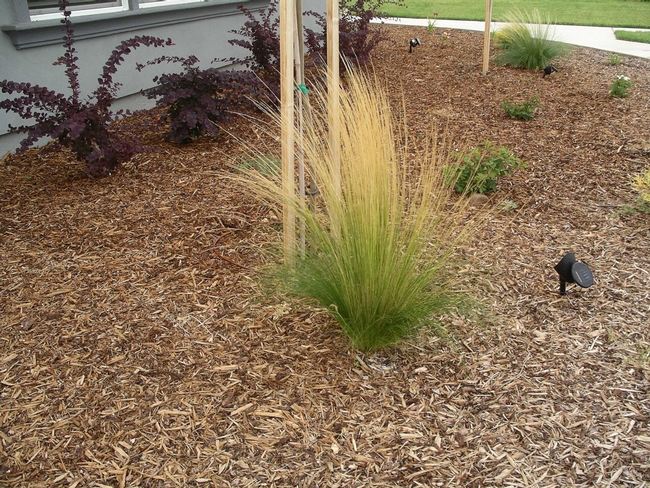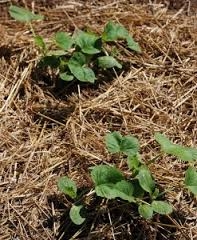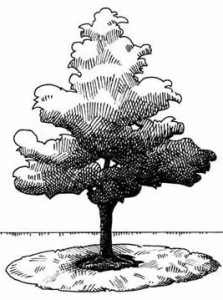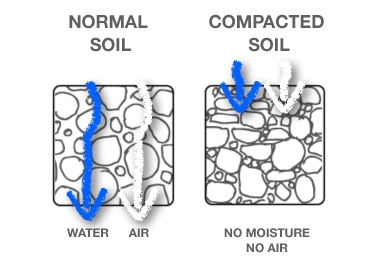By Michael-Anne Foley, Butte County Master Gardener, January 22 2016.

When is soil more than just dirt? When you want to grow healthy plants in your yard and garden, the soil is as important a factor as are water and sunlight. You can improve your soil's ability to support thriving plants of all kinds by protecting it from compaction, amending it with nutrients, and adding mulch as a top dressing. An ideal soil includes various proportions of clay, sand, humus, water and air. You can smell a good soil!
Why is Compacted Soil a Problem?
Compacted soil has less air and is less porous than well-aerated, friable soil. This means it is harder for roots in compacted soil to grow and harder for those roots to get air. Restricted roots are often unable to take up sufficient water or nutrients from the soil. These conditions inhibit plant growth, particularly during drought if soils are dry.
Compacted soil layers can either hold water in (by creating poor drainage), or keep water out (by preventing inadequate water infiltration and creating conditions that are too dry for plant growth and development).
A large number of organisms make up the “soil food web.” They range in size from tiny one-celled bacteria, algae, fungi, and protozoa, to nematodes, earthworms, insects and plants. These organisms are beneficial to plant health but also have difficulty living in compacted soil.
How to Prevent Soil Compaction
- Keep foot traffic limited to a few areas in the garden by using consistent pathways.
- Avoid walking on wet soil and in areas where you have recently loosened the soil.
- Working compost into soil can help alleviate soil compaction by improving soil structure, aeration, and water-holding capacity.
Amending the Soil
Soil amendments improve the physical properties of soils. They increase the water and nutrient-holding capacity of soil and improve aeration and water infiltration. Soil amendments are more than simply fertilizers. Fertilizers (especially synthetic chemicals) add nutrients to the soil for immediate use by plants, but little is retained in the soil. Soil amendments such as compost, humus, worm castings, and aged or composted animal manures improve the soil by making its texture and drainage more conducive to plant health. Soil amendments add nutrients to the microbes in soils, and the microbes then make those nutrients available to plants. The soils that help our foods and landscape plants grow are not sterile but are filled with microbes that are unseen by human eyes. These microbes make our soils healthy and productive.
Amendments are best chosen for the needs of the soil based on how the plants are performing. Landscape plants, annual flowers, and vegetables all have different needs. Commercial producers of amendments tailor blends to generalized garden uses. Some companies offer specific combinations of amendments for specific needs. Worm castings and homemade compost have been found to be among the best amendments because their ingredients are completely broken down and plants cannot be burned by concentrated synthetics.
Two useful websites to consult when determining appropriate amendments for your own yard are the “Analyses of Soil Amendments” at Analyses of Selected Soil Amendmentsand “Amendments for Landscape Soils” at Amendments for Landscape Soils
Using Mulch in the Garden
Mulch performs a number of important tasks in the landscape, and is particularly useful for the following purposes:
- Smothering weeds
- Retaining soil moisture
- Moderating soil temperature
- Feeding the soil by adding organic material as the mulch breaks down
- Alleviating soil compaction by absorbing pressure due to foot traffic
Types of Mulch
Mulch can be organic or inorganic. Each type has its uses in the landscape.

- Yard waste: grass clippings, leaves and small twigs can be used as mulch in moderation and may be best for use behind bushes or borders. Mulching with yard waste functions better when it is composted first. Because yard waste tends to look unsightly, a uniform mulch is often more attractive.
- Straw keeps weeds down and is good for vegetable gardens. It has a short life span.
- Pine bark and needles are good for weed control. Barks last longer, while needles allow water through.
- Wood chips: bark and wood pieces are attractive, provide good weed control and save water.
Inorganic mulch
- Landscape cloth of a woven material provides good weed control, allows air and water to pass through and, if used with organic mulch, can save time and labor for years to come.
- Black plastic can work well for annual plants like strawberries that can be planted through holes in the plastic mulch. Landscape plants, however, will not get enough air, water or nutrients.
- Rocks and gravel are relatively permanent but can be expensive. Decomposed granite tends to stay in place and look tidy.

- Spread a two-to-four-inch layer of organic biodegradable mulch over tree roots, shrubs and plant beds. Keep mulch two inches away from the woody trunks of trees and shrubs.
- Replenish annually or as needed to keep a two-to-four-inch layer. This depth is ideal for weed suppression and water conservation.
As you plan your 2016 garden, keep in mind the importance of keeping the soil aerated by preventing compaction, amending the soil, and mulching to conserve water and fight weeds.
